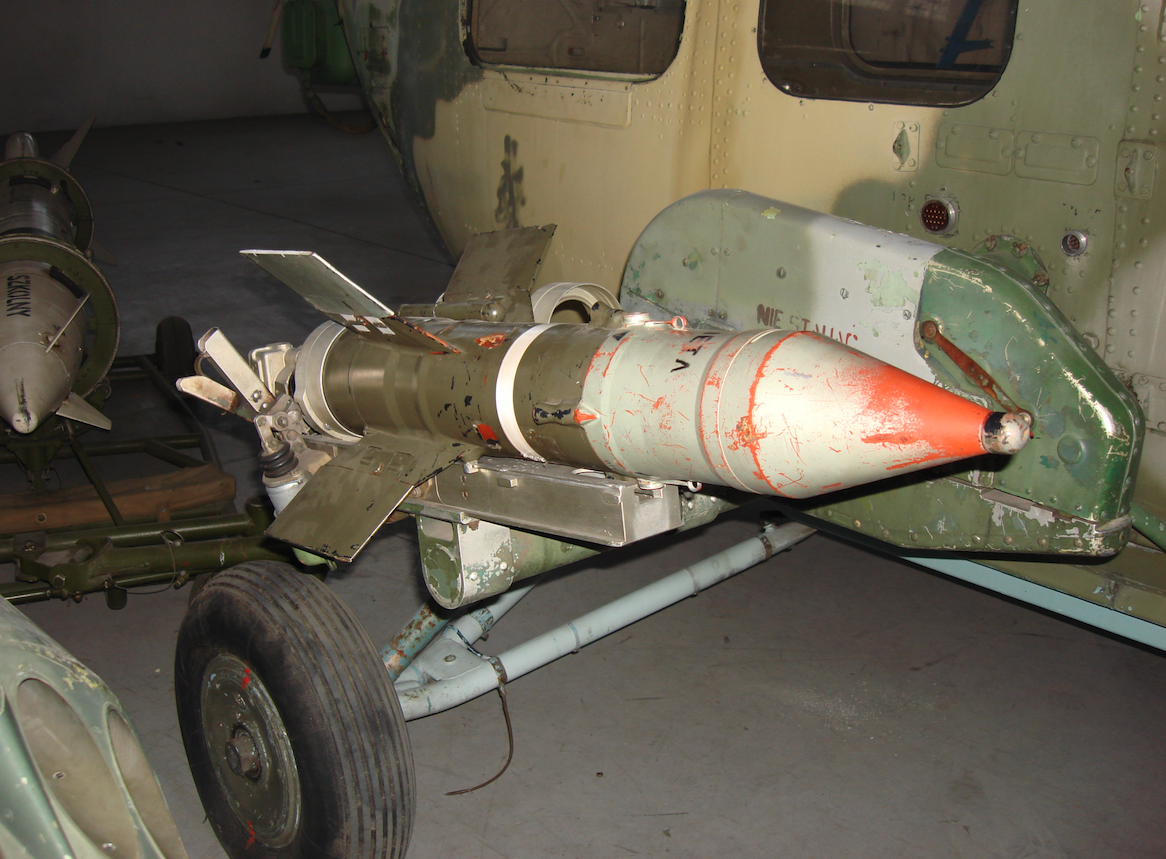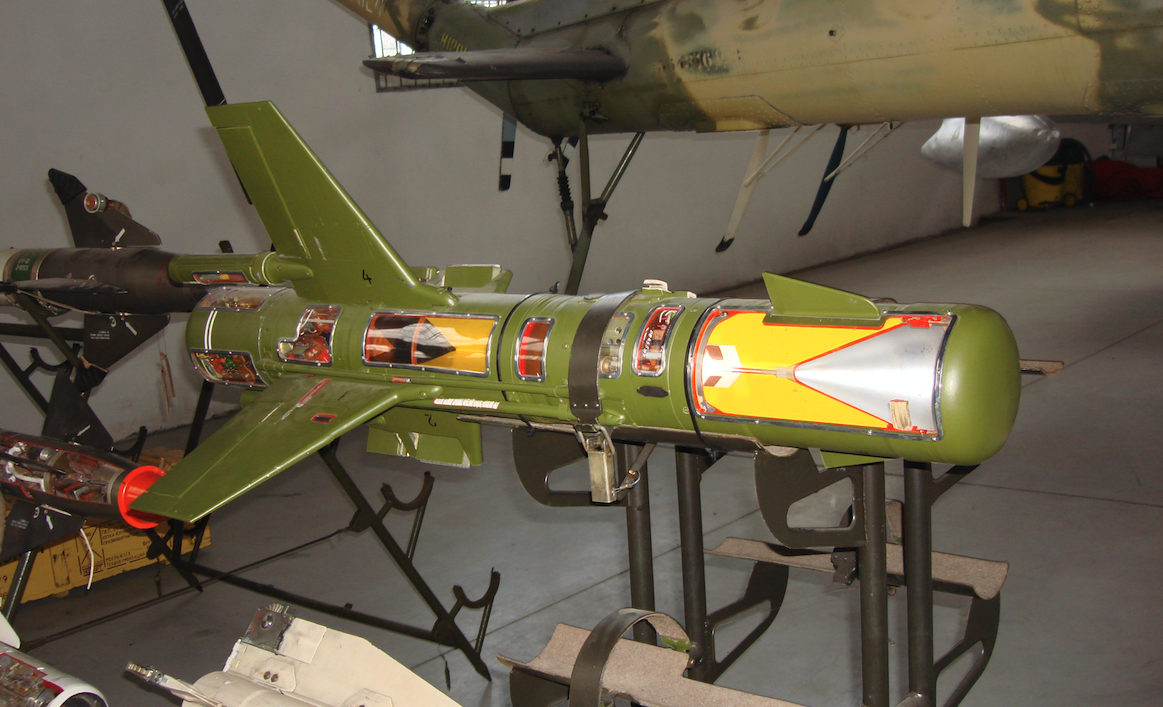Kraków 2020-10-16
Missiles 3M6 Trzmiel, 9M14 Malutka, 9M17P Scorpion
The guided anti-tank missile 3M6 Trzmiel.

The experience of the Second World War has shown that missiles are an extremely effective weapon. Already during this war, the CCCP combat aviation used unguided missiles. The first anti-tank guided missiles were developed by Germany at the end of World War II. A certain amount of these missiles ended up in the hands of the Red Army. From 1949, combat aircraft equipped solely with missiles were introduced into the US. Initially unguided. It was only a matter of time before the introduction of airborne guided missiles, not only to destroy air targets, but also to armored weapons.
The first guided missile of the surface-to-ground class (tank, armored vehicle) in the CCCP was the 3M6 Trzmiel missile. The 3M6 Bumblebee missile was constructed by a team of engineers working at KBM in Kołomno. The 3M6 missile was modeled on the German MBB Cobra missile and the Swiss Mosquito. Work began in 1955. The 3M6 Trzmiel missile entered service in 1959.
The first 3M6 Trzmiel missiles were mounted on sets designated 2K15, on GAZ-69 cars, in Poland called "Gazik". The vehicle had four 2P26 launchers and a total of eight 3M6 Trzmiel missiles. Poland has bought a license to produce 3M6 Trzmiel missiles.
Projectile description 3M6 Trzmiel.
The 3M6 Trzmiel projectile is relatively small. Large trapezoidal wings are attached to the body in a cross arrangement. The wings are equipped with elevons, and additionally there are tracers on two wings. Cumulative warheads were placed in the front of the missile. Inside the missile there is a battery, two spools with cables, and a starting and marching engine for solid propellant.
The 3M6 missile is guided by electrical signals transmitted through wires. The missile is controlled by a console that was placed in the vehicle (for example, a light combat vehicle) or from a remote console, the control cable of which was 30 m long. The missile was supplemented by an observation device, for example a periscope or binoculars, which were attached to the tripod.
The launcher operator first turned on the power to the rocket assembly. He selected the missile he wanted to use on the console. The confirmation was the lighting of the appropriate lamp. The next buttons are checking the system and launching the selected missile. After pressing the start button, the on-board power source was activated, the gyroscope, missile control system and the start engine were activated. The starting engine accelerated the missile to a speed of 100 m / s. The march engine kept the projectile speed constant. After starting from the reels, the signal wires unfolded in the missile. The missile was not guided for the first 600 meters. Then the operator could correct the missile trajectory using the stick on the console. Guidance was visual and manual. Projectile tracers were intended to help the operator aim the projectile, but sometimes the resulting smoke obscured the target. Thus, the accuracy depended on the operator's experience. The missile was flying low to the ground, so the wires could get caught on an obstacle and break. Even a well-trained operator achieved accuracy of up to 70 percent.
Data T-T missile 3M6 Trzmiel.
Projectile weight 24.3 kg. Diameter 0.136 m. Wingspan 0.75 m. Length 1.148 m. Minimum, effective range 600 m. Maximum range 2,000 m. Flight speed 100 m / s. The cumulative warhead pierces 300 mm of armor.
The guided anti-tank missile 9M14 Malutka.

The 9M14 Malutka missile is the first air-to-ground guided anti-tank missile used in the Polish Aviation. The carrier of the missiles was the PZL Mi-2 helicopters.
9M14 Tiny rocket missile: Length: 860 mm, Span: 393 mm, Diameter: 125 mm, Weight: 10.9 kg, Speed: 115 m / s, Range: 500 m - 3 km. However, the 9M14 Malutka missile has a high firepower. It pierces armor with a thickness of 400 mm. Therefore, it has become a good alternative as an armament for the PZL Mi-2 helicopter. Four 9M14 Malutka missiles were placed on the Mi-2 URP Salamandra helicopter. Projectiles are fired from ATGM launchers. The NS-23 gun was left. This time the pilot's cabin was modified, because the right seat was taken by the operator of anti-tank guided missiles. It uses a control panel which consists of 2 lights, 5 buttons, one switch and a control stick. The shooting process was easy. After making the decision to open fire, the shooter selected one of the four guides with the switch. If the rocket was in place, the indicator light came on. After pressing the button, the rocket took off, flying straight for the first several dozen meters. Only after a while the operator could take control of her. The rocket, while flying towards the target, spins around its axis at a speed of 8.5 revolutions per second, which helped to maintain the correct direction of flight. The control was carried out by means of 2 movable nozzles. After detonating the rocket, the operator used one of the 4 buttons that activated the so-called "scissors". If he hadn't, the rocket-control cable would have been trailing behind the helicopter. While guiding the rocket, the operator usually used his own eyesight, because the scope used is not stabilized sufficiently.
The guided anti-tank missile 9M17P Scorpion.

Signs 2K8/3M11/9M17 Falanga/Skorpion are the designations for missiles from the same family.
The experience gained during the operation of the 3M6 Trzmiel missiles as well as other research and experiments led to the development of new anti-tank missiles. Almost simultaneously, three types of missiles were introduced into production: 3M14 Malutka, 3M11 Falanga i 3M7 Drakon.
The 3M11 Falanga anti-tank guided missile was developed at the Precision Equipment Design Bureau (KBToczMasz). The missile was initially too complicated and too unreliable. After modifications, its designation was first changed to 3M17, then to 9M11, and then to 9M17. The Falanga missile was adopted in 1962.
In 1968, a version of the 9M17M missile entered service. It was the first version to be produced on a large scale. Like its predecessors, it was guided by electrical control through wires that unrolled the spools in the projectile. After firing the missile, the weapon operator tried to keep the target in the sight, the missile, the marker in the sight (three-point method).
In 1969, another version of the 9M17P was created. It was guided by the SACLOS method. SACLOS method (short for Semi-Automatic Command to Line of Sight) - a method of guiding second generation guided missiles. The weapon operator only had to keep the sight marker on the target. The missile was tracked by the apparatus attached to the carrier. The goniometer measured the angle between the sight line and the missile, and based on this measurement calculates the missile control commands. Due to the automation of the guidance process and the elimination of a significant proportion of errors that could be made by the operator, the probability of hitting the target has increased to 90 percent.
The missile was used by wheeled combat vehicles and by Mil Mi-24 combat (attack) helicopters. The first four Mi-24 D helicopters were delivered to Poland on September 20, 1978. Together with them, the 9M17P Skorpion missile was delivered. The 9M17P Skorpion missiles were used in Poland until their stocks were exhausted, around 2012. There were no new contracts for new missiles, as contracts for new combat helicopters were awaiting.
Data T-T missiles 2K8/3M11/9M17 Falanga/Skorpion.
3M11 / 9M11 missile: Projectile weight 26.5 kg. Diameter 0.132 m. Wingspan 0.65 m. Length 1.16 m. Range 500 - 3,000 m. Speed 150 m / s. Armor penetration 480 mm.
9M17 / 9M17M missile: Projectile weight 29.5 - 31.5 kg. Diameter 0.142 m. Wingspan 0.65 m. Length 1.16 m. Range 500 - 3 500 m. Speed 150 m / s. Armor penetration 500 - 510 mm.
9M17P missile: Projectile weight 32.5 kg. Diameter 0.142 m. Wingspan 0.65 m. Length 1.16 m. Range 250 - 4,000 m. Speed 150 - 170 m / s. Armor penetration 520 - 650 mm.
Written by Karol Placha Hetman
